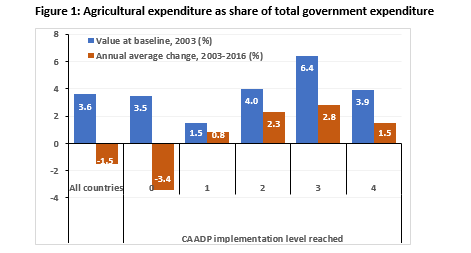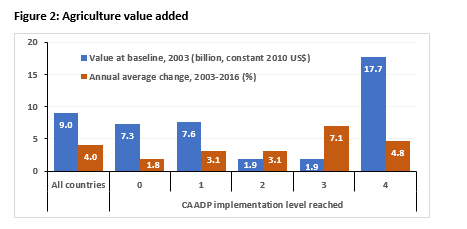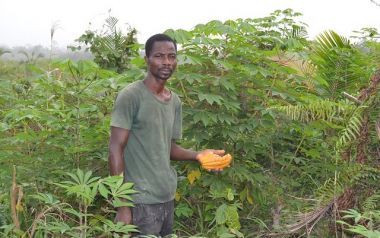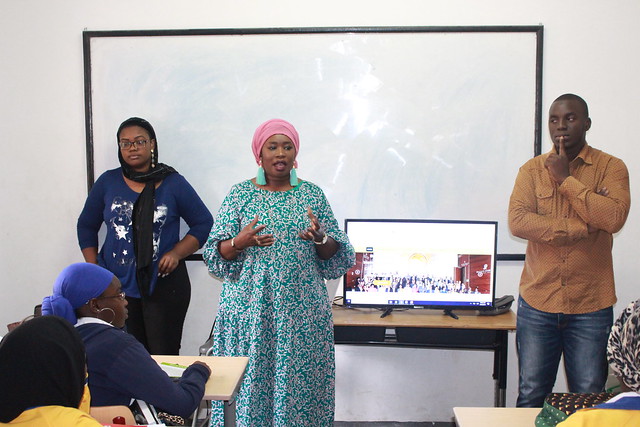Tsitsi Makombe, Senior Program Manager, IFPRI; Samuel Benin, Deputy Division Director, Africa Regional Office, IFPRI.
With the Comprehensive Africa Agriculture Development Programme (CAADP) now well into its second decade, many have wondered whether the framework has had any appreciable impact on desired agricultural growth and development outcomes. A recent study by Samuel Benin of IFPRI set out to shed some light by examining the impact of CAADP on key outcomes of increasing government agricultural expenditures and boosting agricultural productivity.
But first, what does CAADP Offer Countries?
CAADP was adopted in 2003 by African heads of state and government as Africa’s policy framework for transforming the agriculture sector and achieving broad-based economic growth, poverty reduction, food security, and nutrition. It offers African countries a clear set of principles, best practices, and thematic policy guidance, as well as targets by which they can align their individual agricultural strategies and plans to fit local realities and capacities.
Adoption of CAADP is usually followed by countries i) identifying agriculture sector priorities for growth and investment through a CAADP Compact that is signed by all key state and non-state actors, and ii) developing a detailed national agriculture investment plan (NAIP) that lays out sector priorities and programs as well as financing modalities for achieving sector objectives and targets. Of the 42 countries implementing CAADP, Mauritania is the only country in northern Africa that has formally adopted the CAADP. Mauritania signed its compact in June 2011. Nonetheless, several countries in the region (Egypt, Mauritania, Morocco, and Tunisia) have been part of the Biennial Review (BR) process to assess progress against 43 performance indicators, leading to the inaugural African Agricultural Transformation Scorecard and Continental BR Report, recently launched at the January 2018 African Union Summit of heads of state and government.
Progress in Achieving Key CAADP Targets
Figures 1 and 2 show trends in two well-known CAADP indicators (of allocating 10 percent of government total expenditures to the agriculture sector and achieving a 6 percent annual agricultural growth rate) across four different levels of CAADP implementation reached by groups of countries. The results show baseline values at the launch of CAADP in 2003 and changes over the entire period for CAADP implementation, 2003-2016. The Figures show that, on average, in 2003, performance of the group of countries that has not adopted CAADP (level 0) is fairly similar to the average performance of all African countries. However, during the period of CAADP implementation, groups of countries that have reached higher levels of implementation (levels 1 to 4) registered a higher average annual growth in agriculture expenditures (Figure 1) and a higher average annual agricultural growth (Figure 2) compared to the group of countries that have not adopted the CAADP process (level 0)–these include northern Africa countries of Algeria, Egypt, Morocco, and Tunisia. Mauritania which has signed a compact is part of the group of countries that have reached level 2 of CAADP implementation.

Source: ReSAKSS, 2017
Note on CAADP implementation level: 0 =group of countries that have not started the CAADP process or are pre-compact;1 =group of countries that have signed a CAADP compact; 2 = group of countries that have signed a compact and formulated a NAIP; 3 = group of countries that have signed a compact, formulated a NAIP, and secured one external funding source; 4 = group of countries that have signed a compact, formulated a NAIP, and secured more than one external funding source.

Source: ReSAKSS, 2017
Note on CAADP implementation level: 0 =group of countries that have not started the CAADP process or are pre-compact;1 =group of countries that have signed a CAADP compact; 2 = group of countries that have signed a compact and formulated a NAIP; 3 = group of countries that have signed a compact, formulated a NAIP, and secured one external funding source; 4 = group of countries that have signed a compact, formulated a NAIP, and secured more than one external funding source.
What is the Impact of CAADP on Agriculture-led Development?
The study by Benin uses panel data on 25 countries African countries from 2001 to 2014 to estimate the impact of countries’ implementation of CAADP on government agriculture expenditure, agricultural official development assistance (ODA), and agricultural land and labor productivity. It uses an econometric model that controls for several factors to estimate the impact of CAADP using two definitions of the stage reached in implementing CAADP: i) a binary variable of whether or not a CAADP compact has been signed and ii) a four-level ordered variable of the level of CAADP implementation reached.
The results are consistent with the trend observed in Figure 1 by showing that having signed a CAADP compact has a positive and statistically significant impact on government agriculture expenditure and agricultural ODA, after controlling for several factors that affect CAADP implementation and public expenditures. The effect is even larger for countries that have reached higher levels of CAADP implementation beyond signing a compact. However, the analysis shows the effect of CAADP implementation on agricultural government spending and ODA to decline over time, indicating a substitution effect between government funding and external funding for agriculture. This is to be expected, as countries tend to bring in more external funding the further they get in implementing CAADP. In addition, signing of a CAADP compact and reaching higher levels of CAADP implementation is estimated to have a positive and statistically significant impact on both labor and land productivity.
CAADP adoption and implementation are key to transforming African agriculture
The estimated positive impacts of CAADP on government agricultural expenditures, ODA, and agricultural productivity underscore the value addition of CAADP adoption and implementation in improving agriculture sector growth and development. This should serve as a rallying call for countries to further raise investments for increasing agricultural productivity which are central to truly transforming African agriculture. Moreover, as countries stand to benefit from the CAADP framework, those that have not formally adopted it, including countries in northern Africa, should consider doing so.
In addition, results of the inaugural CAADP BR report and scorecard show that countries are making good progress toward achieving 2014 Malabo Declaration commitments. Africa as a whole registered strong performance in terms of i) the recommitment to the CAADP process by having improved plans, policies, and institutional arrangements to support CAADP and Malabo implementation and ii) establishing inclusive platforms for mutual accountability and peer review. A total of 20 out of 47 reporting countries obtained an overall agricultural transformation score of at least 3.9 out of 10, indicating that they are on track to achieving Malabo commitments by 2025. In northern Africa, Morocco, with a score of 5.5, is among the top 5 countries that made the most progress. Nonetheless, the BR report also highlights the urgent need to strengthen agricultural data quality, analysis, and monitoring and evaluation systems to drive agricultural transformation in Africa.
Read original blog posted on IFPRI Egypt portal

